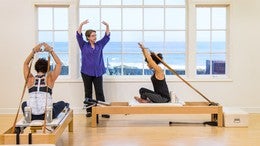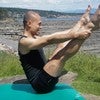Description
About This Video
Transcript
Read Full Transcript
Hi and welcome. I'm Rachel Taylor Siegel from the [inaudible] center in Boulder, Colorado. And we're going to do a short tutorial, um, about how the hands work and how, um, how important they are. Just like we spend so much time as pled as teachers talking about how to pull your belly in or how to breathe or how to use your hamstrings versus your hip flexors. And we never, we rarely get to the extremities, um, particularly the feet and the hands and the hands support us and so many different exercises and they're like the portal of between the springs in PyLadies to our belly to our full body connection, um, as we perform an exercise. And so if we're missing anything, but in this case, if we're missing the hands, um, they're gripping too hard, they're bullying the equipment or they're not being used sufficiently and therefore they're not receiving the springs well enough into the body, all kinds of, not quite enough. Um, then we are going to end up with less than we could get as the product of a full body workout and the uniform development that we're looking for.
And, um, and all the other great goals and PyLadies that Joe talked about in terms of, uh, oxygenation even and, um, better circulation and the internal shower and that kind of thing. So, um, if you are ready to pay attention to something new for awhile, we're going to look at the hands and we're going to look specifically at, um, the beanbag exercise Labib mic exercise, although it is an optional thing, Joe made it and it's a very important piece of equipment in that we have a lot of clients who do very little with their hands, wrists, four arms, uh, other than, you know, texting and using the computer or driving something that doesn't require a great deal of, um, strength. And however, in Palase we use the hands as part and parcel of what holds us up or moves us in relationship to the, uh, equipment. And we often find somewhere around intermediate level, we have a client who complains to us that their hands hurt, their wrists hurt when they do this exercise. And we're thinking, well, why should that be the case? They'd been fine until now. And oftentimes the optional exercises have been designed to fill in the gaps when the imbalances have are too great for whatever reason, whether it's strategies or pain or an injury doesn't matter really. But the imbalance has been too great and we run up against it now.
And so it doesn't really matter if you've been doing Polonius for 10 years and you've never seen the beanbag, it's a great piece of equipment to pick up and start putting into your workout here and there, um, because it will change the rest of your body, um, as well as your hands, wrists, and forearms, which is what it looks like. So, uh, amazingly enough, you can have a very strong client and yet when they go to do the beanbag, which is about three or four pounds worth of beans inside or in our case, rice and something, um, it's heavy and people are supposed to hold it out in front of them with very straight arms, shoulder width and parallel to the floor. And they're very surprised, uh, at how difficult it is. Not to mention coordinating the gesture of the, what the hands and fingers should be doing on, uh, on the wood dowel. So we can start out very simply. And I brought, um, just a wood dowel for Laurel, the floral, um, to use. And she can, she can simply just roll the dowel forwards backwards. Right? So here she's pulling it back to her and we see that she keeps her arms.
There's no weight to speak of. She keeps her arms pretty much parallel to the floor, parallel to one another, pretty straight and she's moving. A lot of the movement is happening in the wrists, secondarily in the, um, hands. Okay. And rest a moment. Okay. So some clients that can be too much for even so and so you can have them sit down. Oftentimes if I have someone for whom that's too much, I'll have them sit inside the ladder, barrel on a stool, and then their arms can be up on the ladder and the weight of their arms can be reduced from, uh, them having to hold their arms up in their shoulders and their neck. And so they can actually start to build the strength even in something as simple as that, um, without getting corresponding tension in the neck and upper back.
And so then they have a little bit of more strength in their hands. They have a little bit more strength up their arms than they can go on to the next step, et Cetera, et Cetera, which is what PyLadies does anyway that we've, uh, in the layers of one, two, three, four, five are beginning, intermediate to advanced, etc. So, um, when we take it to the beanbag and there's weight there, there's also directional pull from the, um, from the bag itself. Usually the is about three pounds and it's on a, um, a rope that is close to six feet long. So ideally, the full out version of it is we would have Laurel standing up on maybe a low chair where she could keep her arms straight and square the whole time, breathing in and out with her belly pulled in and move the, the dowel or move the back all the way to the floor and back all the way up. And that would be, uh, from our standpoint, that would be towards the Cirque de Solei, uh, and the realm of how to use the beanbag.
But today we're just gonna start out and we're going to start doing it the same way we did the dowel. So I'm not going to request a whole lot of finesse at first from my client. She's going to hold this back about the same way she held before and um, she's going to just move the thing and she gets the gratification of watching the bag go down and it also gives her some, um, organization and coordination into her arms, even though it's a challenge because of the weight that she didn't have when it was just the Dow and then pull it back up so she feels how she's moving this, this, a circumference of that Dow one way or the other and therefore the bag moves and then we're going to make it be a little more challenging and a little more full range of motion. How you doing? You want to take a little break first? Okay. So as she moves forward and she lets the down of course it will depend, pull it down just to see just a moment, like two inches. Okay. It will depend if you have put the bag on the outside, which is I feel is a better place. Um, then on the inside, both of which work, but when it's on the inside, it tends to kind of pull, pull, make you pull into your body in a funny way, um, that when it's on the outside, you're better able to address it correctly through all the link system of the hand, arm, shoulder into the body, um, and get to the belly.
Okay. All right. So as she goes, she's gonna let the bag down first, obviously, and her wrists are going to go forward and she's going to take her knuckles down. And so when she takes her knuckles down as she, let's go from this hand and grabs with this, she's gonna flare and bring her hands back. So she's going to try and flex her wrist as much as she can and pull her fingers back as far as she can grab it and take it forward. Right. Breathing, pulling the belly and all that other stuff that's polite. He's keeping a square shoulders in the standing on the good feet, et cetera. And then on the way back, just start out pulling it back a moment.
And then we noticed that she has to grab at the bottom and throttle back kind of if you've ever been on a motorcycle. So she takes her fingers all the way down to the floor and then her wrists rotate backwards. Meanwhile, her arms are straight shoulder with, she's palming that bar back through her packs, even into the posterior shoulder. So she pulls the bar gently to her, even though she keeps her elbows straight, it should turn, it should pull her tummy in nicely up here. Rest. I'll take it from you for a moment. That was really good. So we don't use our arms and hands this way any other time in pallet's really.
So the movement itself is a new challenge. But the product that it gives us supports us in a lot of different exercises from the basic pushup and long stretches to even how we use our arms in the hundred and in overhead and rollover. I mean it's just everywhere. So, and once a client has experienced the bean bag, and in truth they could do it 5% well and you would be happy because they have started to get strong, they have started to get warm and therefore we know that something productive is going on. And we can take not only what happened to the muscles and the whole body, but we can take what happened to the mind as she's figured out how to do the thing and take it anywhere. We want to, to use it as an image to relate, to relate back to as a teacher would does all the time. And so, um, so let's take, let's take that, well let me say this first.
Let's, let's think now past the basic mechanics of how to do the beanbag exercise and how full range it can be done and how square and you know, beautifully it can be done. There is something that we didn't really address that's maybe a little richer and a little less um, obvious and that is the quality that the hand has when it meets up with the wood of the dowel. So we can, we probably, most of us as teachers have said things like, don't let the springs bully you or don't push that a piece of equipment around but that you want to meet it. We want to partner with it. Um, and Joe did say, um, that he made the as extra muscles so that you could do things so that he could do things. He could have the client do things that were otherwise impossible for them. He could have the clients do things that he didn't have to help them with as much as the teacher gets a little bit of a break too. But the part for me that's really interesting about that is the part that the springs act as extra muscles to your body. So if, if we allow that to occur, if we seek it out at and are interested in it, then it, it really behooves us to understand how does the hand meet up with its extra muscles and what do those extra muscles therefore do as they come through?
Kind of the portal of the hand through each joint and along the bones in the Fascia, whatever part of it you want to be thinking about and paying attention to that particular day or month with your, that particular client. And so we're going to take it to the pedal pole and as the Laurel's gonna stand and just with her heels together, toes apart and pull out ESV and her spine up against the pedal pole on her hands out in the width of the, um, a springs arm springs. And so, um, we all know that the Pious v standing, um, gives us this nice pelvic power and that her belly drawing in and up along the pole, whether her spine can actually touch the entire pole or not, the attempt to do so engages her core muscles. And when she inhales up and exhales and pulls her belly and all that stuff is the same as anywhere else in [inaudible]. Okay. So the thing we're going to be really interested in right now ourselves is how does she hold on to the extra muscles of those springs? What's their job and how can she get them to do their job or get out of the way?
So they do do their job and therefore receive the benefit that they have. So the place that she's touching them is here. And so that would be one where we would direct our first attention anyway. And do we want her to stretch her fingers out and push the springs away from her? So oftentimes when someone's pushes the springs away, they will lock their elbow, they will stretch out and send the energy away. Sometimes it reverberates back into their core, but sometimes not.
And sometimes it takes them on to the outer sheath of their bodies and it doesn't make them be centered. So let's say if she, let's, let's keep that feeling, if you would, Laurel of pushing out like rays of a star and bring your arms down. Let's do an arm circle. So she brings her arms down, inhaling comes forward and of course Laurel is a very good student and she's going to make it look really nice. Your clients will not look quite that nice and exhale open. Okay. So if you, if we want, if we can do it one more time, if you would, if we watch and see as she moves the springs around, how they relate to her as if they were a quadricep or a hamstring or a tricep, et cetera. We see that we see it a certain way.
Let's not even say how we see it, but then if she makes a gentle fist and let's say she's going to address this, would I'm going to give her something interesting. Think about, so that she, um, so that she doesn't have to shows her, so she doesn't work too hard in a very simple gesture, which is another important aspect of it. So as her hand surrounds this wood Dowel, I'm gonna say, hold on to it. Like it's a little baby bunny and it's squiggly and it could jump away and you don't want it to jump away. But on the other hand, you don't want to squish it either. That's Kinda Gross, but all right. So as she holds on to the baby bunny, a different thing occurs throughout all the cells of her muscles. Then if she held, if she gripped a p, a would handle.
So now take hold of the wood handle and grip it. So hopefully you can see in the film that there's a tightness that occurs in certain places that when it's a baby bunny and she has to take hold of it and hold and keep it from running away, you see that, um, it spreads out the energy of her efforting and it brings her into her center. Am I kinda true? Am I right about that? Okay, good. So, so her belly turned on s okay. And if her belly turns on, we know are in the right track. So that's one thing we can be sure of, even if it's 1% so she's holding these baby bunnies and she's gonna move them around in the circle and it's a whole different length in the torso and a whole different tone in the belly. And as she inhales, wait, come back, come back down if you would. So they take your baby bunnies, even when the spring gets harder, they're still baby bunnies, right? So we get this nice lift under here, which picks her rib cage up off her lungs and lets her inhale bigger, which is one of Joe's goals.
And then as she exhales and she's holding the baby bunnies ever so right. She's controlling every Amilla moment of movement on the way up. No matter how fast we could go 10 times faster in this exercise, as long as she's got baby bunnies or whatever it is that works, then we know that she's going to get a fuller experience, a fuller, a more full body experience, and therefore more [inaudible] rest a moment and relax. Okay. So, and if she gets more full body [inaudible], she has to do fewer reps unlike this tutorial and she will receive more benefit sooner and therefore progress faster and can move onto something else. So we're going to turn her around and do the last thing, which is the chest expansion and the chest expansion. What we, what we hope to see because she's, and maybe baby bunnies start to lose her interest.
So maybe we have to change it to something else. We'll see. But as she, as she keeps herself alive to the possibility of being interwoven with her extra muscles and not just move the springs or move your arms and don't care that there are springs, we should feel, um, a sequencing of the gesture correctly. We should see it. She should feel it. And, um, an activity in her abs automatically without us teachers having to say, pull your belly in. We should hear a better breathing. Um, both the inhale and especially on her exhale. So we've seen when we did earlier the, the, um, bean bag that it's easy for Laurel to hyper extend to her elbows. And if she does that, she kind of dams up the energy of this springs and doesn't let it get even to her shoulders, let alone to the rest of her torso. So here, if she's going to hold the wood handles in a certain way that doesn't let her, doesn't encourage her to hyperextend her elbows because she's actually using strength where she hadn't been using strength before in her hands in her wrists, then it will go through the elbow. Almost like if you looked at the, um, uh, cardboard to being that Christmas wrapping comes on, we should be able to see from the palm, the energy course through all the joints, even her shoulder joint, and come through and enter the belly. And even though she has her back to us, we should be able to know that the belly is turning on because we will see that the first joint to move will be the shoulder joint and then it will traverse through the upper back from shoulder blade all the way to the spine and crack the walnut as Ramana always to ask us to do.
If she skips a joint, her belly won't turn on. If she doesn't hold the baby bunnies or whatever it is, we've determined them to be as well as she could today. Then her belly won't turn on and we'll be sitting dancing. They're saying and pull your belly and please Laurel, but we don't have to do that. So as she surrounds the wood, as if it were a squiggly little Easter chick and it could hop away or bite you or something, I don't know.
And it's so soft and the bones are so teensy and so as you hold on, it's not the fingers that are going to grip so hard, but the whole hand from fingertip all the way through palm to the heel of the hand is surrounding as best it can, fully the wood just with the image. So we're not going to make a big deal out of it in a class. We're going to try and find something really quick that will make this happen. So as she surrounds the wood and starts down, she can extra bend her wrist. She can't lock her elbows that she doesn't want to with the bunnies or the chicks in her hand. She wants to take those chicks ever.
So careful without losing them down down too. So here's the springs are too strong for her down through and here as she takes the chicks behind her, we see a nice dimpling in the back of her shoulder and a, uh, pink newness that comes into her shoulders and upper back. As she exhales, I'm going to say resist going forward so she doesn't skip any delicious moments. And she takes those baby chicks. Not, she doesn't have to pick them up. She has to hold on to them so they don't hop away.
Exhale your breath. Nice. Do you have a more in you? Okay. So let's help you on the first part. Okay. Otherwise we could stand her on something like a short box or we could make the springs less tense by putting extra clips. All right. So we have her hands surrounding the, the baby chicks and, and you know, I mean if you pictured it just for a brief moment, if you had a baby chicken your hand, what would the quality be like? And that's one of the thing a teacher does, right, is figure out ahead of time or throughout their entire life all the time, different images in different, uh, relationships that, that they could use with their client. So she's surrounding, she's pulling the chick cause she knows the choreography of the exercise.
So she's taking the chick down behind her. She doesn't have to lock her elbow, she has to move the chick without losing it. And that makes her move her short arm and her shoulder joint. And right here where if I wasn't helping her and she didn't think about the chick, she would lock her elbows. She's gonna take her arm in her shoulder joint behind her and squeeze her blades finally cause there's nowhere else to do it. That kind of gesture. And then as she starts the exhale, she's going to hold the chick, not the neck but the chick. Right. And the wonderful thing here, although the springs are just ever so too strong, is that rest is that the springs do the job of holding Laurel's arms up so she doesn't have to use the muscles that hold the arms up.
She just has to hold the wood. And if she can do that, then she will be directed away from misusing these muscles and instead use their cohorts or their agonists or antagonists, I'm sorry. And strengthen both concentrically and east centric Lee, the whole upper body based on how she did, how she addressed the wood with her palm, with herself, and even back from the Om. You can turn around and shoot even back from the, um, being back. Okay. And then we'll take this, I'm going to teach some classes that have, uh, the theme, the focus beyond how the hands address whatever part of the equipment that they're touching. And we'll see, hopefully the same kind of fast results.
Comments
for share your deep knowledge
I like see you and learn of you
Is the bean bag exercise eventually also to be performed with thumbs with fingers (no motorcycle grip) more like on the long stretches series on the reformer?

You need to be a subscriber to post a comment.
Please Log In or Create an Account to start your free trial.


















